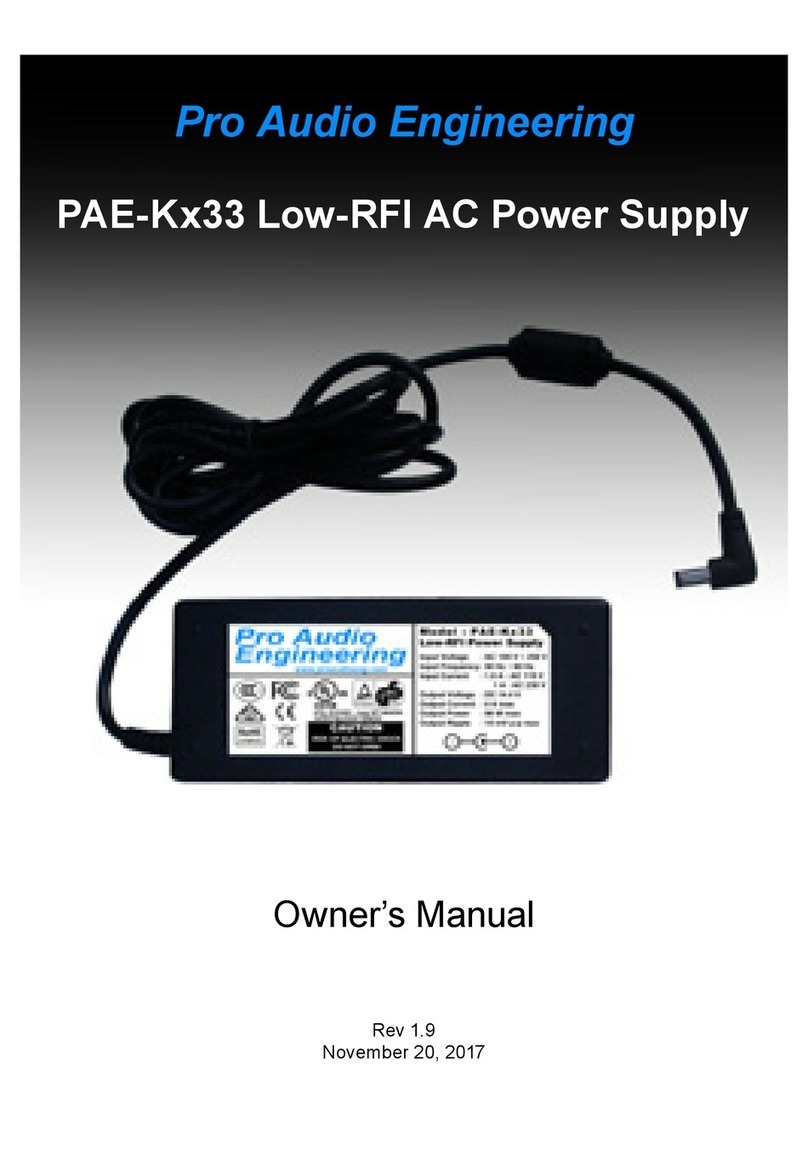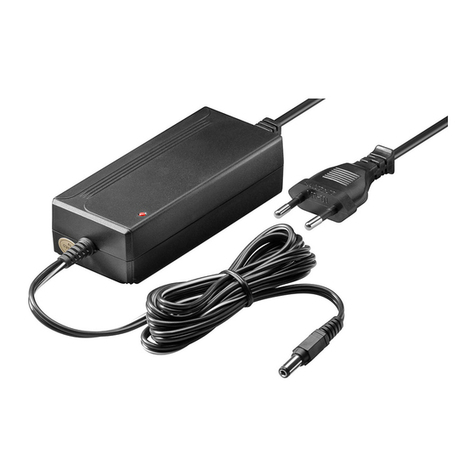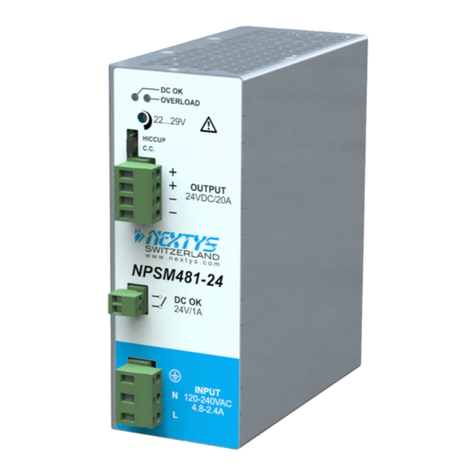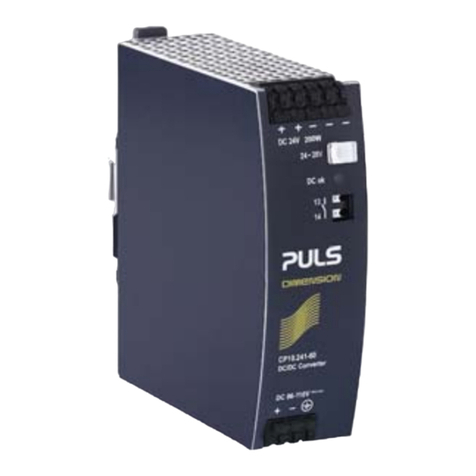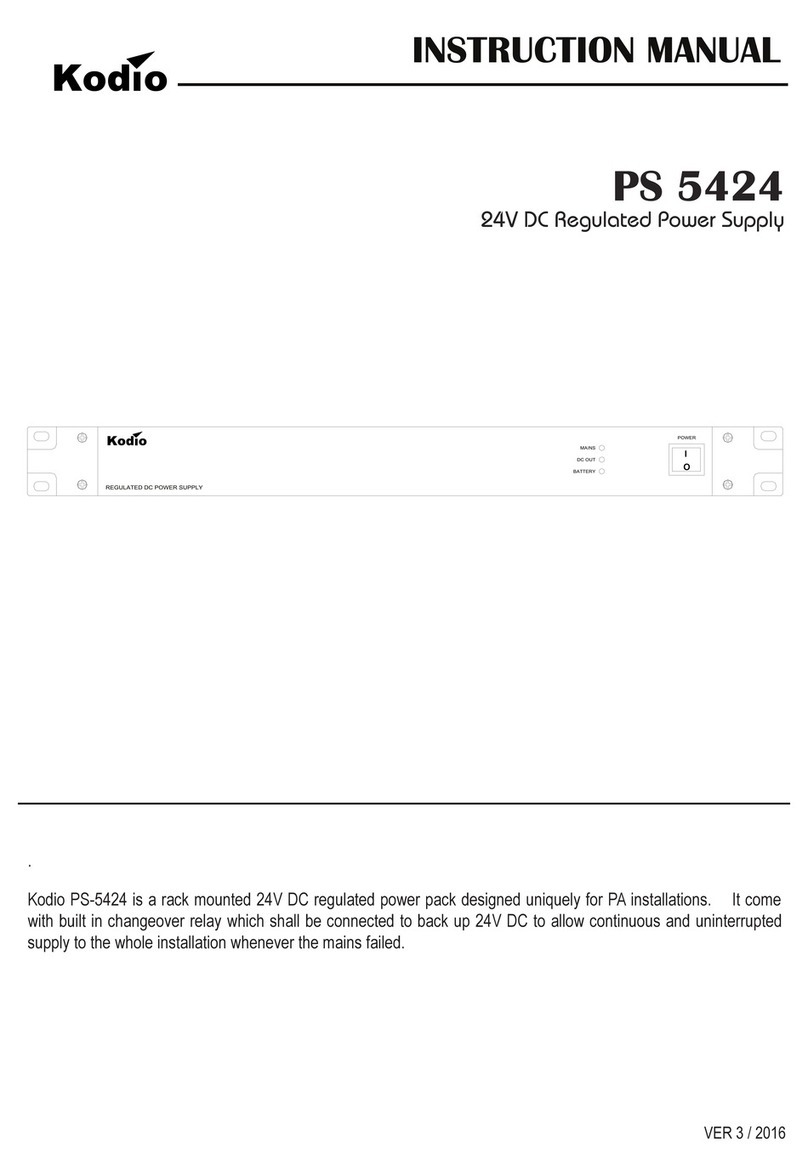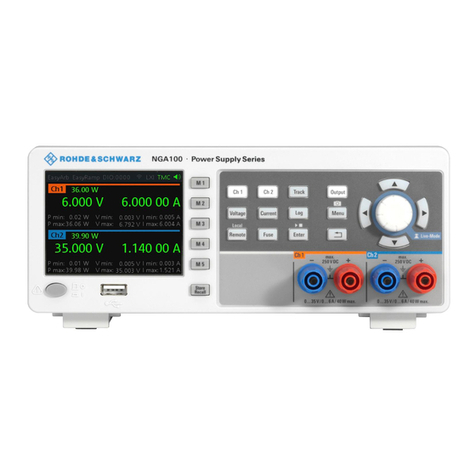Pro Audio Eng PAE-Kx33 User manual

Owner’s Manual
Rev 1.5
February 20, 2015
Pro Audio Eng
PAE-Kx33 AC Power Supply
for the Elecraft™ KX3 Transceiver (and others w/ adapter)

Thank you for purchasing the PAE-Kx33 AC Power Supply.
We originally designed this power supply for use with the
Elecraft™ KX3 Transceiver, but it is perfect for use with any device
requiring 12-14VDC at up to 4A.
This supply was specically designed to power high-performance
communications equipment, and features an innovative design
which inherently minimizes RFI. In addition this supply features
multiple lters to further reduce emissions. The result is a power
supply offering the small size and light weight advantages
of a switching supply without the common disadvantages
of RF noise, poor regulation and others. For full information
on its specications, design and performance capabilities, please
visit: www.proaudioeng.com
We welcome any and all comments regarding the design,
operation or performance sent to: info@proaudioeng.com
Howard Hoyt
WA4PSC
www.proaudioeng.com
IMPORTANT NOTES:
This power supply must be operated from a 50-60Hz AC power
source between 100 and 250VAC ONLY. Operate in an
environment away from direct sunlight or moisture. This supply
should not be used to directly charge a battery, damage, injury or
re may result. Failure to observe these constraints will result in
voiding of the warranty.

Operation:
We suggest you plug the PAE-Kx33 power supply into an AC source
before turning on the attached equipment. If you are using the Kx33
to power more than one piece of equipment at the same time, turn
on the one with the largest power requirement rst. For optimum
noise elimination it is useful to place the supply at the full DC power
cord length away from the rig being powered.
The Kx33 is rated at 4A output, but will produce considerably
more for a period of a few seconds. This allows it to drive large
capacitances and transient loads without current fold-back.
The Kx33 offers comprehensive protection circuitry including input
over and under-voltage, output over-current, over-temperature and
short-circuit protection. These have been incorporated into the
Kx33 to protect your equipment, but they should not relied on as a
replacement for proper wiring or fusing.
At loads less than 25mA the Kx33 enters a skip-cycle mode in order
to maintain voltage regulation. When in this mode there can be
additional noise on the output. For lowest noise it is recommended
that a load of greater than 25mA be maintained. This is standard
behavior for most switchmode supplies.
Some antenna systems will encourage common-mode coupling
through the power supply. This can result in an apparent increase
in noise, but is easily remedied. Please read the following section
on RFI and AC power supplies for more information.

AC Power Supplies and RFI:
When powering a 12VDC receiver from an AC line power source
you may occasionally nd the receive noise oor becomes
contaminated with noise of various sorts which are not present
when powered by a battery and isolated from the AC power system.
It is tempting to believe that all of the additional noise originates
from within the power supply, but this is often not the case. It is a
common misconception that all linear power supplies powered from
the AC mains are as quiet as batteries, and that all switching power
supplies are noisy. The truth is more complicated due to the multiple
routes by which RF Interference (RFI) can be induced into a
receiver.
The main routes for RFI are:
1: Transverse or Differential-mode conduction of RF ripple
superimposed on the DC power supply output can introduce RFI
into the equipment being powered. It is critical for the designer of
a supply to resolve this source of noise inside the supply as it can
cause radiated RFI if allowed to propagate on the DC power cord.
We specically designed the Kx33 to have extremely low RF ripple
on the DC output.
2: Common-mode coupling of the antenna system to the AC
power line through a power supply can introduce several types of
RFI to sensitive receive systems. Since the potential exists between
the AC input and DC output, not between either of the AC input or
DC output conductors it is common-mode. The magnitude of this
type of RFI depends on two main factors:
a. The impedance of the AC input to DC output of the power
supply at the frequency of interest. All AC line powered supplies
have a combination of inductive and capacitive coupling between the
AC line and the DC output. This represents a path for RF energy to
take if a difference in potential exists between the two. When using

a linear supply the instantaneous input to output impedance will be
modulated at the AC line frequency, leading to the hum commonly
heard in older single-conversion receivers. In the case of a switching
supply the coupling can be modulated by the dynamic impedance of
the switching action and can cause RFI. Measurements taken by PAE
show linear and switching supplies to of fer mainly capacitive coupling,
with ~1000pF being average. At <100pF the Kx33 minimizes
this coupling and the magnitude of this common-mode RFI.
b. The magnitude of antenna system voltage on the chassis of
the rig. Well-implemented antenna systems with little imbalance
and small common-mode feedline currents are much less likely
to cause this form of RFI. When operating with a high-impedance
antenna like many end-fed long-wires, or while operating with an indoor
antenna, the use of any line-operated supply can potentially induce
antenna counterpoise currents to be coupled to the AC power system
through the power supply. Inserting a common-mode choke in the
antenna feedline will reduce or eliminate the feedline current ow. An
excellent reference on this subject can be found on K9YC’s site:
http://audiosystemsgroup.com/RFI-Ham.pdf
In order to minimize common-mode coupling through the Kx33
we offer the #33-410 Fair-Rite Ferrite Clamp-On core at our cost
to Kx33 customers at: https://proaudioeng.com/accessories/
Winding the DC power cable 6 to 8 turns through this core will
effectively increase the common-mode impedance of the DC
power cable by >3000 ohms@10MHz, effectively minimizing this
source of RFI. While the Kx33 does feature both input and output
common-mode chokes, we have had a couple of customers inquire
as to why we did not integrate a ferrite choke like this into the
design of the Kx33 itself, and the answer is size, weight, and cost.
The ferrite is over 1/2 the weight and size of the KX33, and would have
increased the cost. For 99% of all users, the RFI performance of
the Kx33 itself will be sufcient, and those users will enjoy a much
smaller, lighter power supply at lower cost.

3. Radiated RFI can come from many sources and can be picked
up by the antenna system or many other cables with poorly
designed shield terminations and appear as a signal in the receiver.
In a well-designed supply like the PAE-Kx33, the external elds
from the high-current PCB loop between the switching devices and
transformer, as well as the elds of the transformer itself are
extremely small. In order to minimize the pickup of any radiated
RFI we recommend placing the supply the full length of the DC
supply cord away from the rig. Another excellent paper on Jim
Brown K9YC’s site shows how improper termination of cable
shields and improper chassis grounding of connector shells
can allow radiated RFI to conduct into our systems:
http://audiosystemsgroup.com/PAARA-RFI-2011.pdf
Less than 1% of Kx33 customers have experienced any additional
RFI caused by proper use of the Kx33. Of those that have, addition
of the ferrite core to the DC power cable has remediated the noise.
We are sure you will be happy with the Kx33 or we will refund both
your purchase and shipping costs, so there is no risk other than a
small amount of your time evaluating it.

Accessories:
33-100 - KX3 & PX3 DC Power
Splitter Allows you to power the
Elecraft KX3 and PX3 from one
PAE-Kx33 AC Power Supply.
33-120 - 4.0mm x 1.7mm DC Power Adapter
Adapts the output of the PAE-Kx33 for use with the
Yaesu FT-817 and others.
33-140 - 5.5mm x 2.5mm DC Power Adapter
Adapts the output of the PAE-Kx33 for use with the
Flex1500 and others.
33-160 - PowerPole DC Power Adapter
Adapts the output of the PAE-Kx33 for use with
any 12-14VDC device requiring a PowerPole
connector such as the Elecraft K3 and others.
33-180 - 28-piece DC Power
Adapter Kit Adapts the output of
the PAE-Kx33 for use with almost
any device requiring 12-14 VDC
power at up to 4A.
33-410 - Fair-Rite Ferrite Snap-It Core (1.5″OD x
0.75″ID x 1.87″L) Useful for choking common-mode
RFI from cables such as the Kx33 DC power cable.
See https://proaudioeng.com for more information and accessories.

Specications:
Input Voltage: 100VAC to 240VAC.
Input Current: 1.6A peak at turn-on,
0.7A max at 100VAC full-load,
0.3A max at 240VAC full-load.
Input Frequency: 50-60Hz
Output Voltage @ plug (+/- 0.1V): 14.4VDC at no load,
14.2VDC at 0.2A load,
14.0VDC at 3.5A load.
Output Voltage as shown in KX3 (+/- 0.1V):
14.2VDC in receive at 0.2A load,
13.6VDC in transmit at 2.4A load.
Output Current: 4A maximum.
Maximum Ripple: 10mV.
Efciency: 82% minimum @ => 200ma load.
Protection: over-voltage, over-current, over-temp., short-circuit.
MBTF: >50,000 hours.
Approvals: UL, FCC GS, TUV, CE, PSE, KC, SAA, CCC
Dimensions (excluding cables): 2″ x 1.25″ x 4.5″
(50mm x 32mm x 114mm)
Cable Length: AC line cord - 58” (1.4M),
DC power cable - 78” (2M)
Weight: supply: 9.3oz (264G), AC cord: 3oz (85G),
total: 12.3oz (349G)
Warranty: 1 year from date of purchase.
Table of contents
Other Pro Audio Eng Power Supply manuals
